We loved our visit to this beautiful area of Spain. The country holds a special place for us as the first European country my kids visited many years ago when we spent time in Madrid. This was our 7-Day Barcelona itinerary that include things to do, muse-see attractions and day trips.
This itinerary is also customizable for 3 or 5-day itineraries depending on your time. I hope this helps with your Barcelona planning especially if you’re not visiting during the summer and not planning to spend a lot of time at the beaches sunbathing or if you’re traveling with teens and tweens.
Day 1 – Parc Guell and La Sagrada Familia
We wanted to cover two of Barcelona’s top attractions on our first day since we knew it was a busy week with many people visiting for the New Year. Antoni Gaudi was a famed Catalan architect. His unique masterpieces and lasting legacies are very much alive in Barcelona. Visiting these two attractions will show you just why he was so admired.
Parc Guell
There is nothing quite like this whimsical and colorful park. Officials hired Gaudi for originally slated as a housing community and park for the aristocrats and the rich. He planned 60 houses (with only two completed), a market and English style gardens but the project never finished. Today, the park covers 42 acres and is a UNESCO World Heritage site.
We loved the terrace area lined with stone benches and colorful tile mosaics. It looked out into beautiful city and ocean views.
The two amusing buildings at the entrance almost looked like Dr. Seuss structures. The wavy benches provided much-appreciated areas for tourists like us who needed a rest.
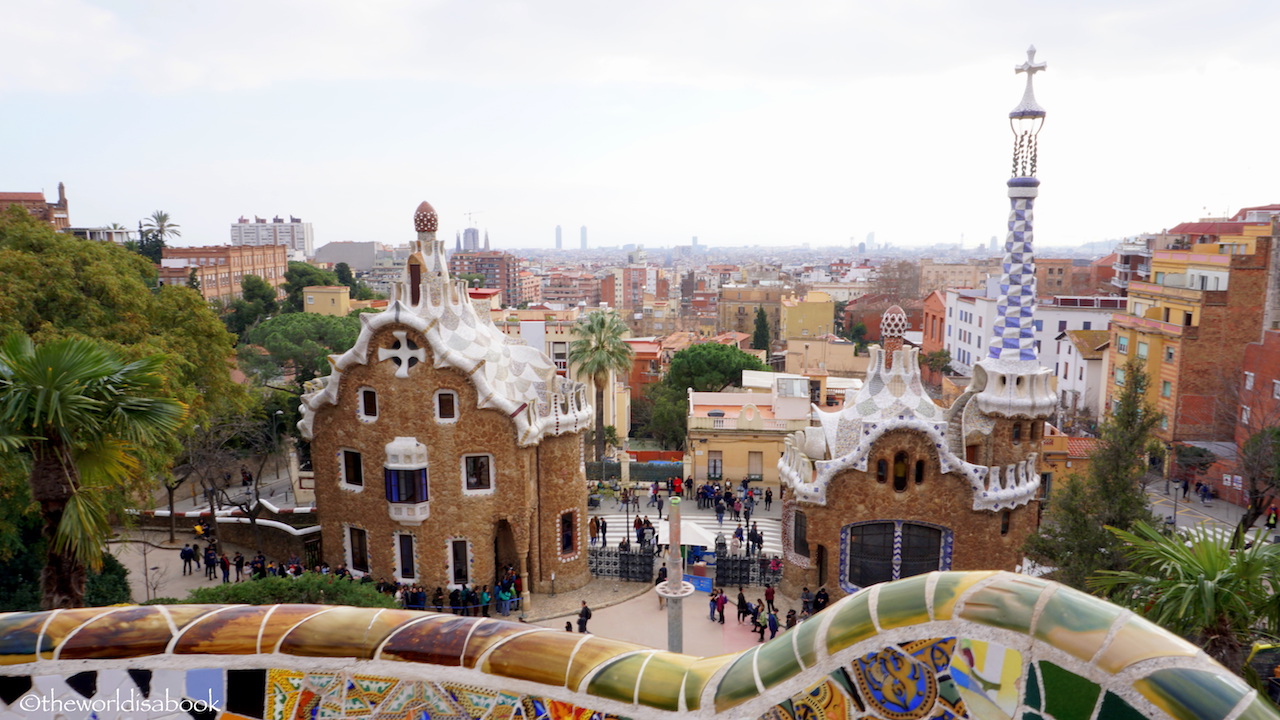
Don’t miss the colorful mosaic lizard seen on many postcards and souvenirs. We easily walked around and admired the quirky structures like the Sala Hipóstila. They intended it as the marketplace with its grand columns and beautiful mosaics on the ceiling.
La Sagrada Familia
We’ve visited many European cathedrals and churches over the years but La Sagrada Familia was certainly one of the most memorable and unique.
Gaudi designed it, and construction started in 1882. By the time he died in 1926, only a quarter had been completed. There have been several projected completion dates over the years, and it’s currently set for 2026.
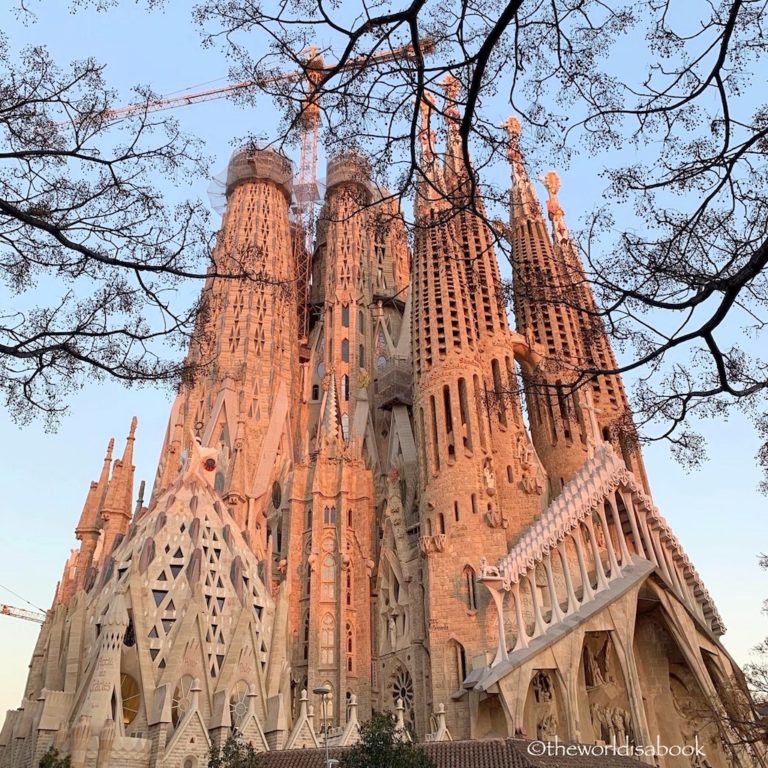
This is a designated UNESCO World Heritage site and a Roman Catholic basilica. The church has three facades to commemorate Christ’s life, death and glory.
Gaudi completed the Nativity Façade and is the most detailed. They built the Passion and Glory Facades much later. The details are beyond incredible.
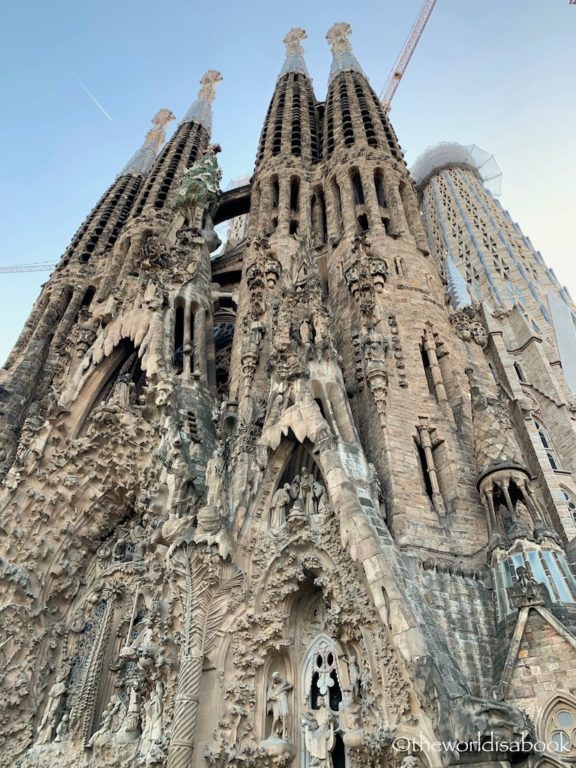
We did the self-guided audio tour which you can reserve online. Other guided tours with locals and experts were also available. We highly recommend going inside to see the amazing interior and marvel at what Gaudi accomplished.
Gaudi designed the interior to resemble natural elements, with the many pillars resembling trees. We were here about an hour before sunset. The lighting coming through the stained glass windows was beyond magical.
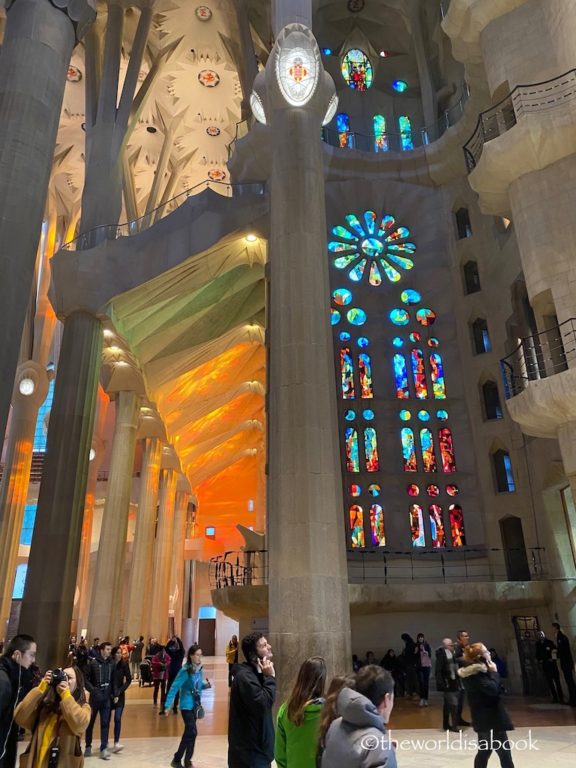
Tips for visiting La Sagrada Familia
- Book entrance tickets in advance for both attractions.
- Arrive promptly for your scheduled timed entry.
- Wear comfortable walking shoes.
Day 2 – Explore Camp Nou, Passeig de Gracia, Gaudi’s Houses and La Rambla/La Boqueria/Gothic Quarter
We are a soccer/football/futbol family. My son has played for many years. He and my husband follow European teams and even did a UK tour of stadiums last Spring.
Of course, they couldn’t pass up visiting Europe’s largest football stadium and home to FC Barcelona – Camp Nou. It was a self-guided tour and well worth it for the guys in my family.
Meanwhile, my daughter and I spent the time before meeting up with them shopping at Passeig de Gracia. This is one of Barcelona’s famous boulevards, lined with stunning architecture and a variety of stores, from Spain’s well-known brands like Mango and Zara to luxury names like Cartier, Gucci, and Louis Vuitton.
Gaudi designed Casa Batllo’s (a townhouse) exterior. It’s a Modernist style with no straight lines and covered in mosaics. The line to get in was quite long when we passed by. Right next door is Casa Amatller, designed by another Catalan architect, Josep Puig I Cadafalch.
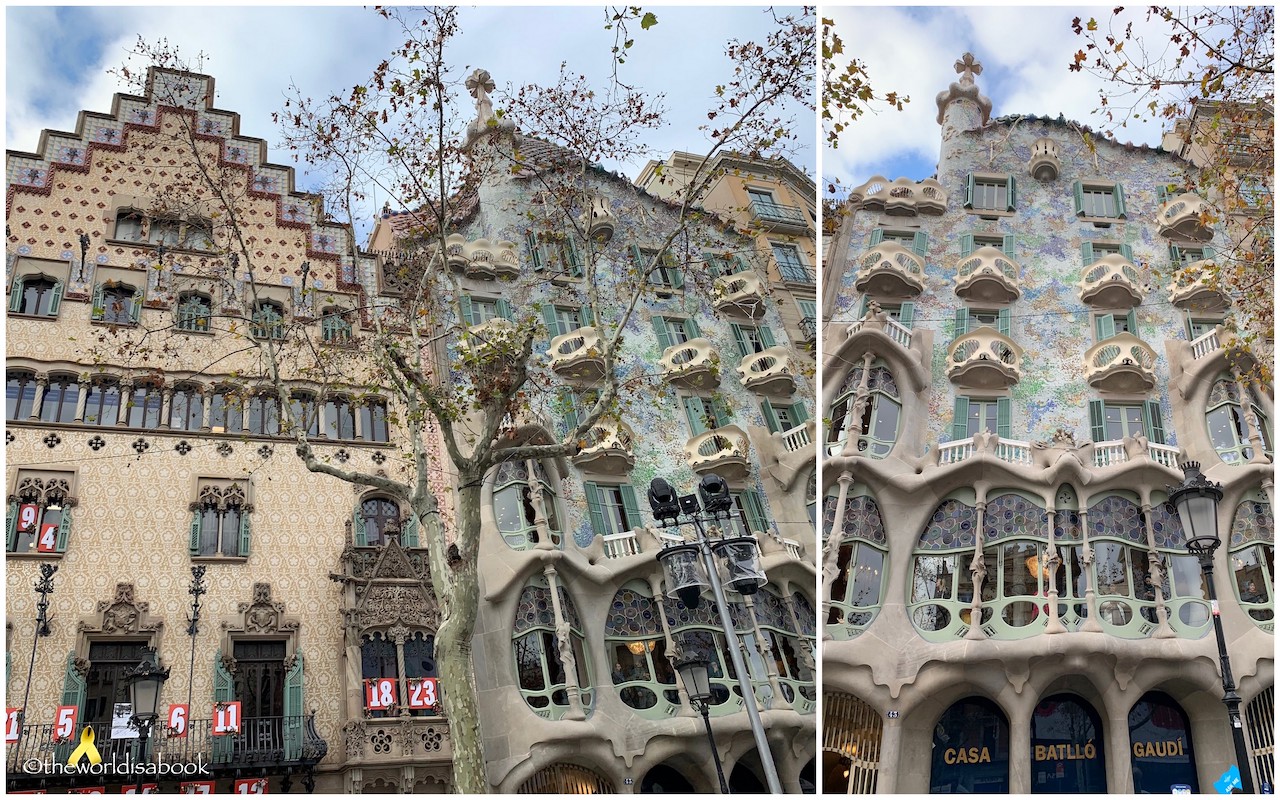
La Rambla connects Christopher Columbus Monument to Placa Catalunya – less than a mile long – tree lined – surrounded by shops, cafes – pedestrian zone in the middle of one lane roads that seemed built for tiny cars. You’ll find everything here. Go off the side streets
You can continue to the monument and waterfront area or make a detour to the Gothic Quarter and La Boqueria which is what we did and recommend.
La Boqueria
Barcelona’s Sant Josep Market or La Boqueria Market was the city’s first local market which opened in 1840. Come here hungry! The food choices were overwhelming inside this covered marketplace. From the bright fruit stalls to the different aromas of the various stalls cooking their specialties, it was really hard not to stop at almost every stall and buy something.
There was no shortage of Spanish staples like paella, jamón ibérico, mancehogo cheese and a variety of seafood dishes. Every other store seemed to be ham shop here which was quite interesting. The market was crowded and lively, but it lacked enough spaces for eating.
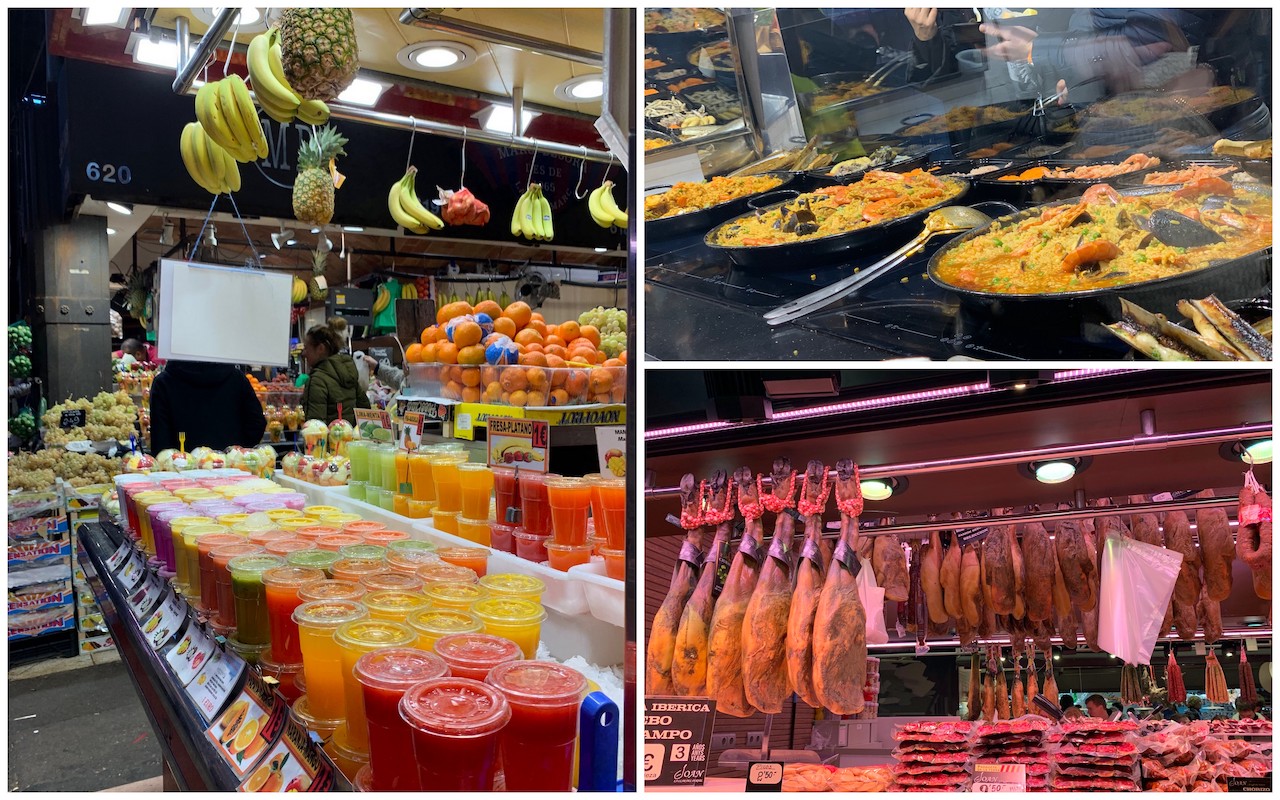
Gothic Quarter
This was my favorite neighborhood to walk around near La Rambla and we returned twice. The Gothic Quarter or Barry Gotic used to be the Roman village. We loved exploring the charming squares, narrow streets and seeing all the beautiful architecture. This area is also one of the best places for shopping. Here are a couple of things not to miss:
Cathedral – The Barcelona Cathedral is grand and impressive. The Gothic arch and façade was very ornate with many details. The stone sculpture of Jesus Christ was over the entrance and the 12 Apostles lining the doors.
Look up and take in all the grandeur. This cathedral first broke ground in 1298 and is dedicated Barcelona’s patron saint – St. Eulalia. There is an entrance fee of about xx euros to enter the church.
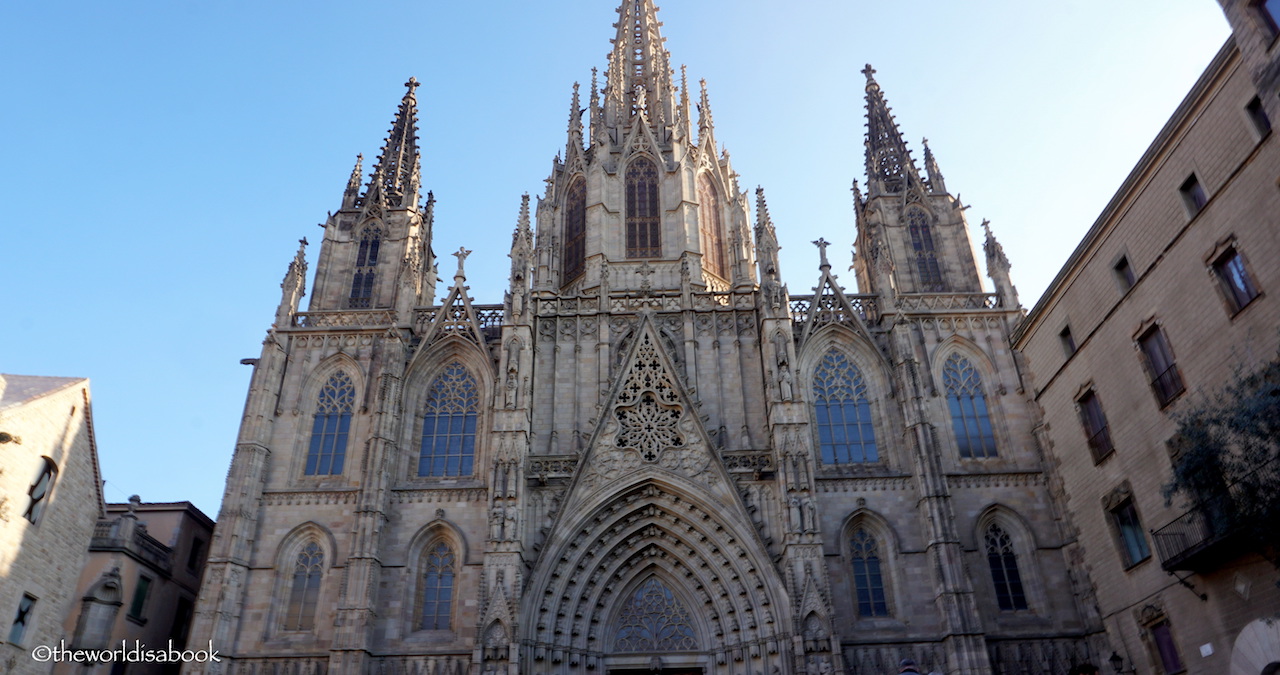
Bishop’s Bridge – Despite the many architectural gems around the Gothic Quarter, one of the most photographed sites is on Career del Bisbe or Bishop’s Street. The Neo-Gothic bridge known as Pont del Bisbe or Bishop’s Bridge is a popular spot for young women especially posing for the ideal social media shot.
The bridge connects the Casa dels Cononges (Catalonia’s presidential palace) and the Palau de la Generalitat building. They built it for the Barcelona International Exposition in 1929.
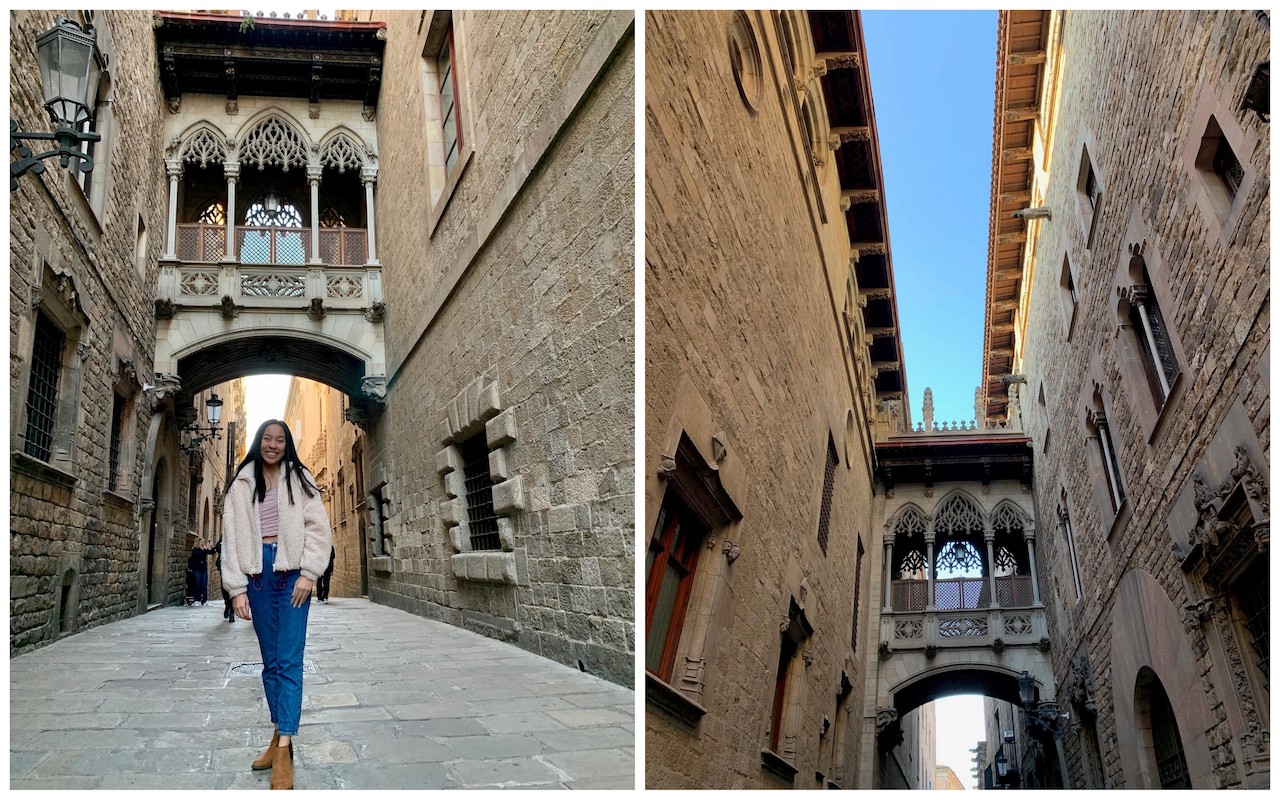
Shopping Tip: For anyone who likes locally made souvenirs and items, espadrille shoes are the ideal gifts to buy for yourself and to take home. Espadrilles are typical Spanish shoes. The upper part is made of canvas, and the soles are crafted from espart, a type of Mediterranean grass used to make rope.
Visit La Manual Alpargatera which was the first store in the area and where you can still see some of the workers making the shoes. Check out other stores like 2espadrilles and Toni Pons.
Food tip: Don’t forget to stop by Chocolat-Box for some churros con chocolate while walking around.
Day 3 – Poble Espanyol and/or Montjuic Area
We modified this day because it was New Year’s day during our visit. Some of the attractions were closed and had modified closing times. We decided to do a tour of Spain by visiting Poble Espanyol.
Originally built in 1929 for the International Exhibition, they created Poble Espanyol or Spanish Village to showcase Spain and its heritage in one area. Most of the original buildings are still intact in a sort of outdoor museum. They designed the entire area to resemble an actual village.
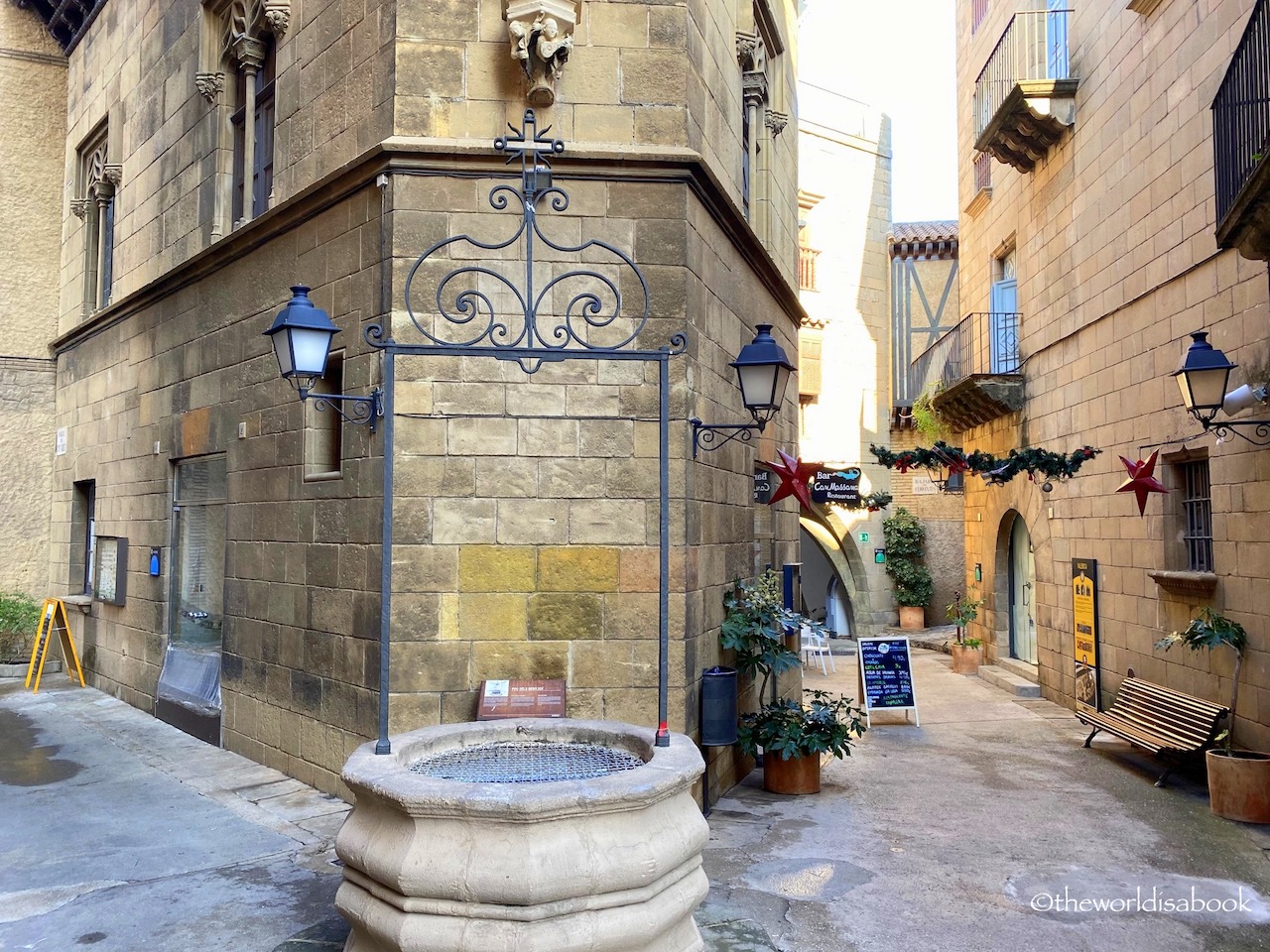
It has 117 real-life scale buildings from the different Spanish regions plus its authentic streets and plazas. We really felt like we had been transported into different cultures and regions, from the narrow alleys of Valencia to the whitewashed buildings of Andalusia.
Although some of the shops were closed, there were various artists and craftsmen demonstrating their skills, offering workshops, and selling their wares. There were many stores selling various handcrafted items and souvenirs along with many restaurants to sample a variety of Spanish cuisine.
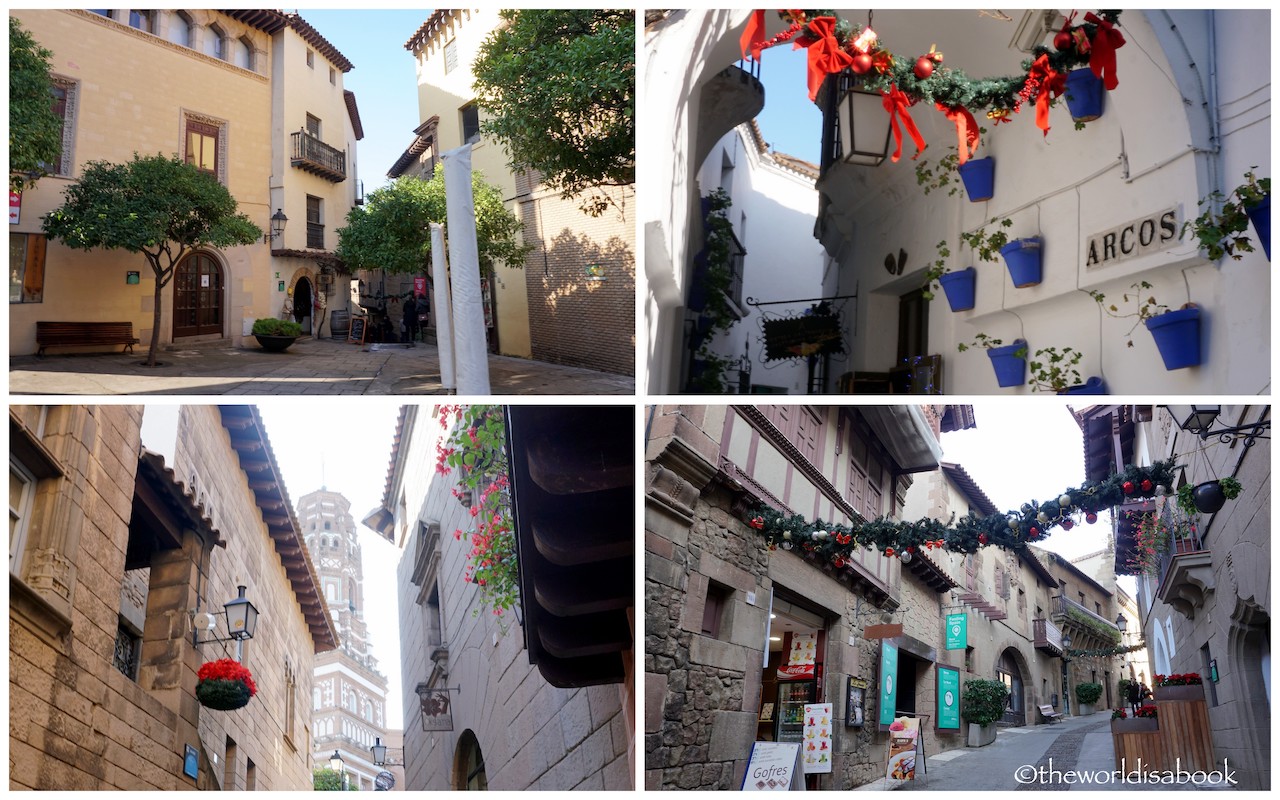
If we were here on another day, we planned to combine Poble Espanyol with a visit to the nearby Montjuic area. You can easily do both in one day.
Visitors can take the cable car (teleferic) to the top of Montjuic mountain to start the visit and work their way down. You can catch the funicular from the Paral-lel metro station.
Montjuic means “Jewish Mountain” in Catalan and was once Barcelona’s Jewish community. The hill has the Castell de Montjuic fortress that was first built in 1640.
This is one of the best places to see beautiful panoramic city views and explore dungeons and a watchtower. You can also visit the Olympic Ring, which includes structures used during the 1992 Olympics.
The imposing Palau Nacional, which looked more like church, is home to the National Art Museum. While the Font Magica or Magic Fountain at the base of the museum doesn’t look very impressive during the day, it is a popular nighttime attraction.The 15-minute water show is choreographed to both classical and pop music.
We spent this night watching a show about surprise…soccer. We were in town for the last few days of Cirque du Soleil’s show about FC Barcelona player Leo Messi. According to my son, the greatest soccer/football player out there right now. It was surprisingly entertaining like previous Cirque du Soleil shows we’ve seen.
If we didn’t watch this show, we planned on watching a flamenco dance show. We’ll have to do that on the return trip.
Day 4 – Day trip to Besalu and Girona
As much as we loved Barcelona, we also wanted to explore some the nearby areas which are easily accessible by bus, train or car. We rented a car for the convenience and to stop at interesting places along the way. We set this particular day for Girona which was almost 1.5 hours away from Barcelona.
Besalu
But, we decided to go a bit further first to explore Besalu which was a medieval village about 30 minutes from Girona. We crossed an 11th century bridge over the Fluvia River to get to the historic area of the town. Besalu looked like a movie set for a medieval period film. I’m sure it looks even more scenic during the summer.
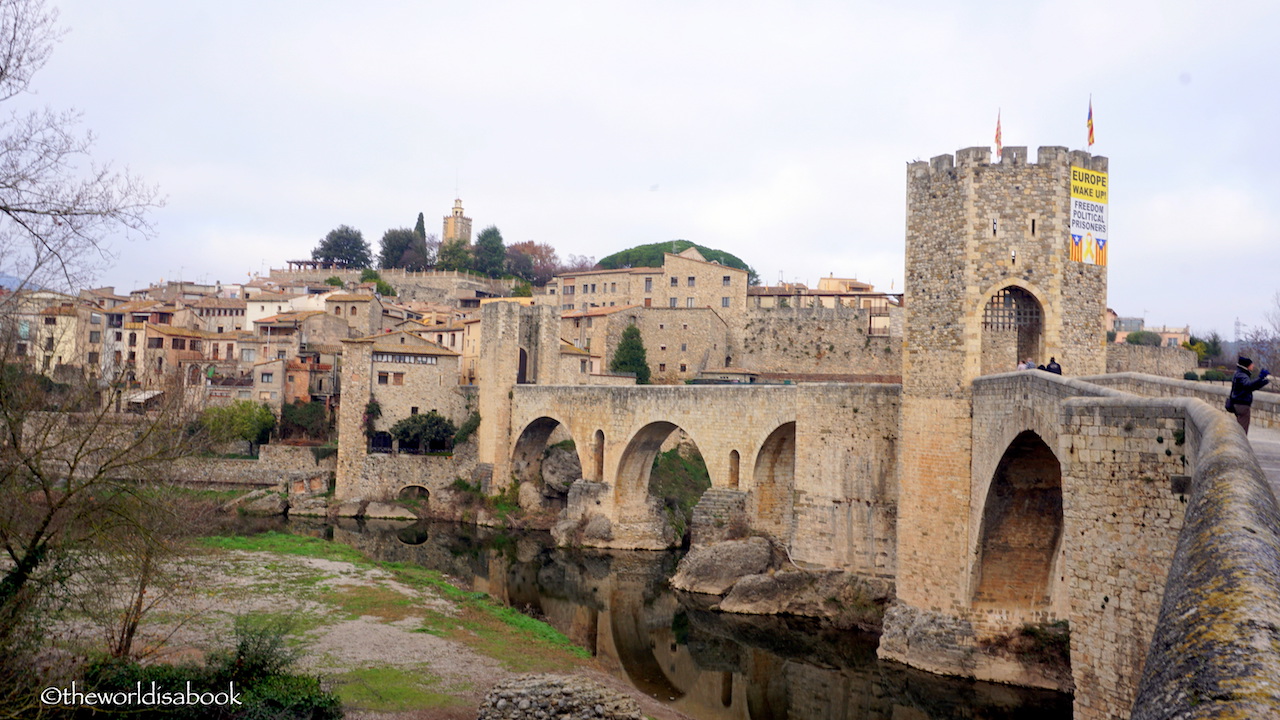
The tourist information told us it would take about 20 minutes to see most of the town’s main attractions and to walk from one edge to the other. It felt like we somehow stepped back in time. We loved walking through the narrow alleys and cobblestone streets and seeing the many stone buildings.
The village only has about 3,000 residents so tourists usually outnumber them. We were here before 10 AM and had some streets to ourselves. It’s always a pleasure to see ancient churches like Sant Vicene and Sant Pere who have withstood the elements of time and weather.
Girona
This city located about 1.5 hour from Barcelona became even more popular after the mega-hit TV show, Game of Thrones, filmed many scenes here for Season 6. There are many guided tours but we opted out of this one and decided to do a DIY version. We loved exploring Girona and it offered so many wonderful attractions.
Several bridges over the Onyar River connected the newer part of Girona to its historic center. The colorful riverside houses make the city postcard perfect especially during sunset. I loved the reflections here. Many of these houses were built in the 19th century and where the medieval city wall used to be.
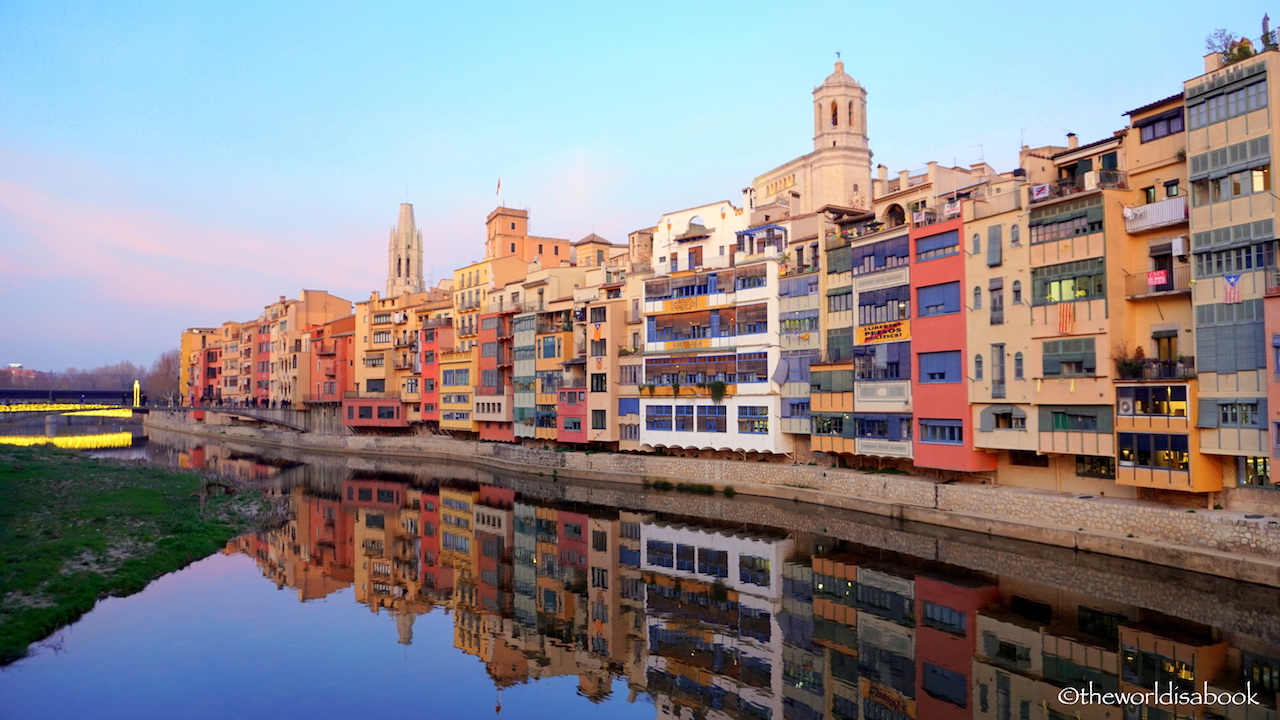
We spent most of our time walking what remains of the medieval city walls or Passeig de la Muralla that surrounded the historic center. Part of these walls have been around since the 9th century. The walls connected various towers to climb up for wonderful panoramic views of the city and beyond.
It spans about 1.9 miles (3 km). We didn’t time it right to watch the sunset from here but this would be the ideal location.
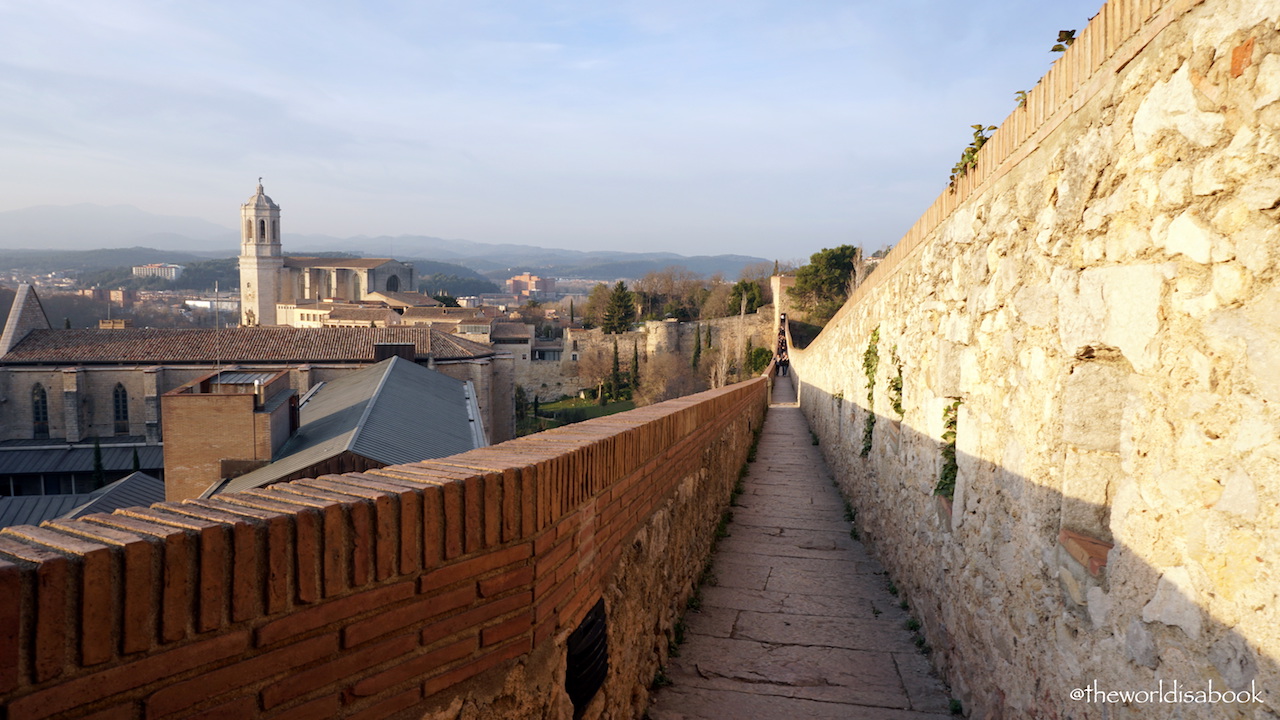
There was so much to see around Girona with its picturesque, narrow streets, quaint squares and bridges. It was fun to just walk with no map and get lost in the historic center. We just used the imposing cathedral as a landmark.
Read more about our day trip to Girona from Barcelona.
Day 5 – Tibidabo
Mount Tibidabo was the city’s tallest peak and hard to miss from anywhere around it. The mountain loomed high and large and topped off with what looked like a fairytale castle. It wan’t the easiest place to get to but definitely worth the trip to see where most local families like to hang out with their kids.
Its prime location meant visitors have the best panoramic views over Barcelona. We got lucky and were here on a nice clear day. Barcelona was such an expansive city and many colorful buildings. I loved that It also has a vast coastline with wonderful landmarks.
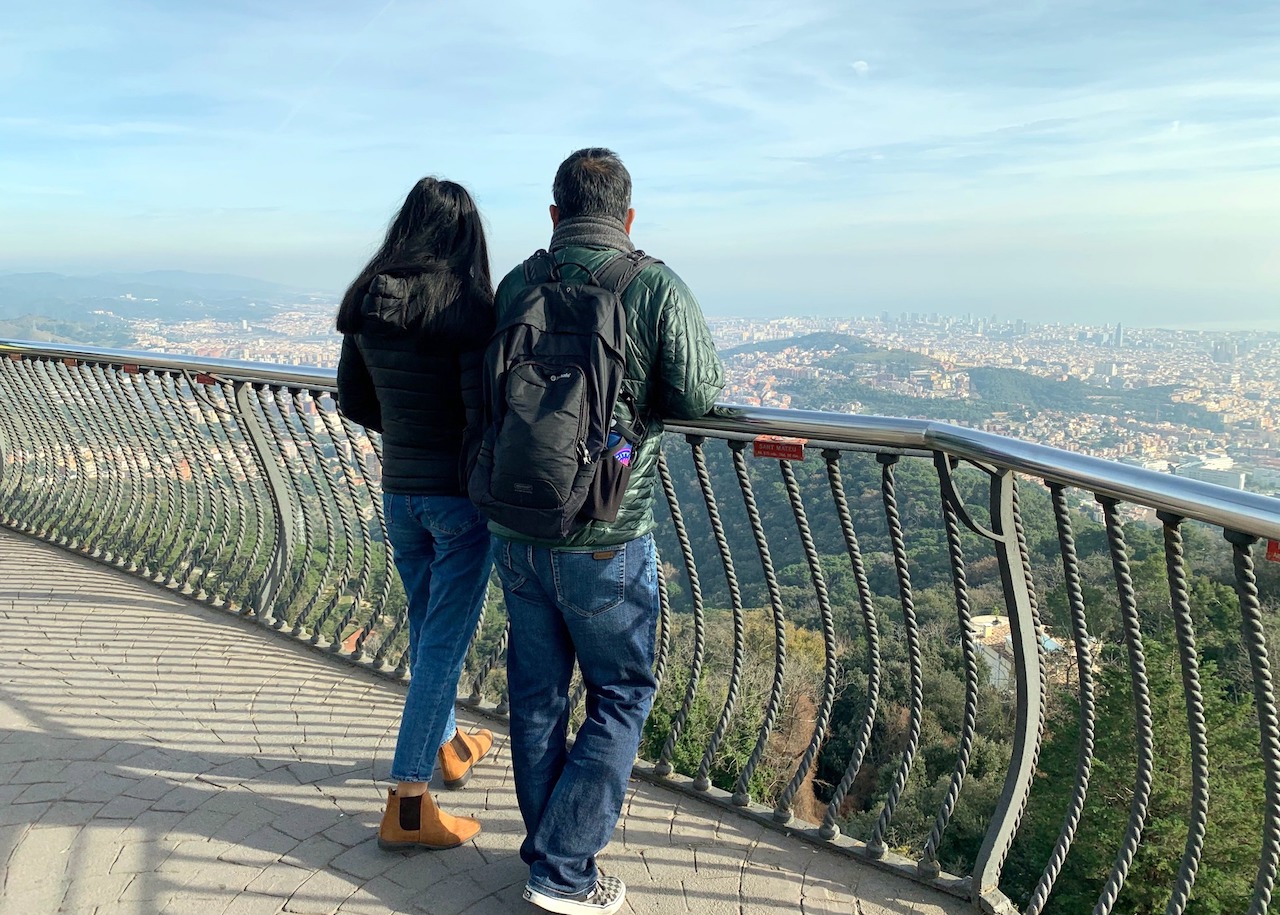
The Temple Expiatori del Sagrat Cor de Jesus or Temple of the Sacred Heart of Jesus, also commonly known as “Temple of Tibidabo” was a beautiful church that seems to watch over the city. There was a large gilden bronze statue of an outstretched jesus Christ that resembled Brazil’s Christ the Redeemer statue at the top of the dome.
The interior was actually smaller and not as ornate as we expected. Visits to the crypt and church are free but there was a small fee to go up the elevator or lift to the temple’s highest point.
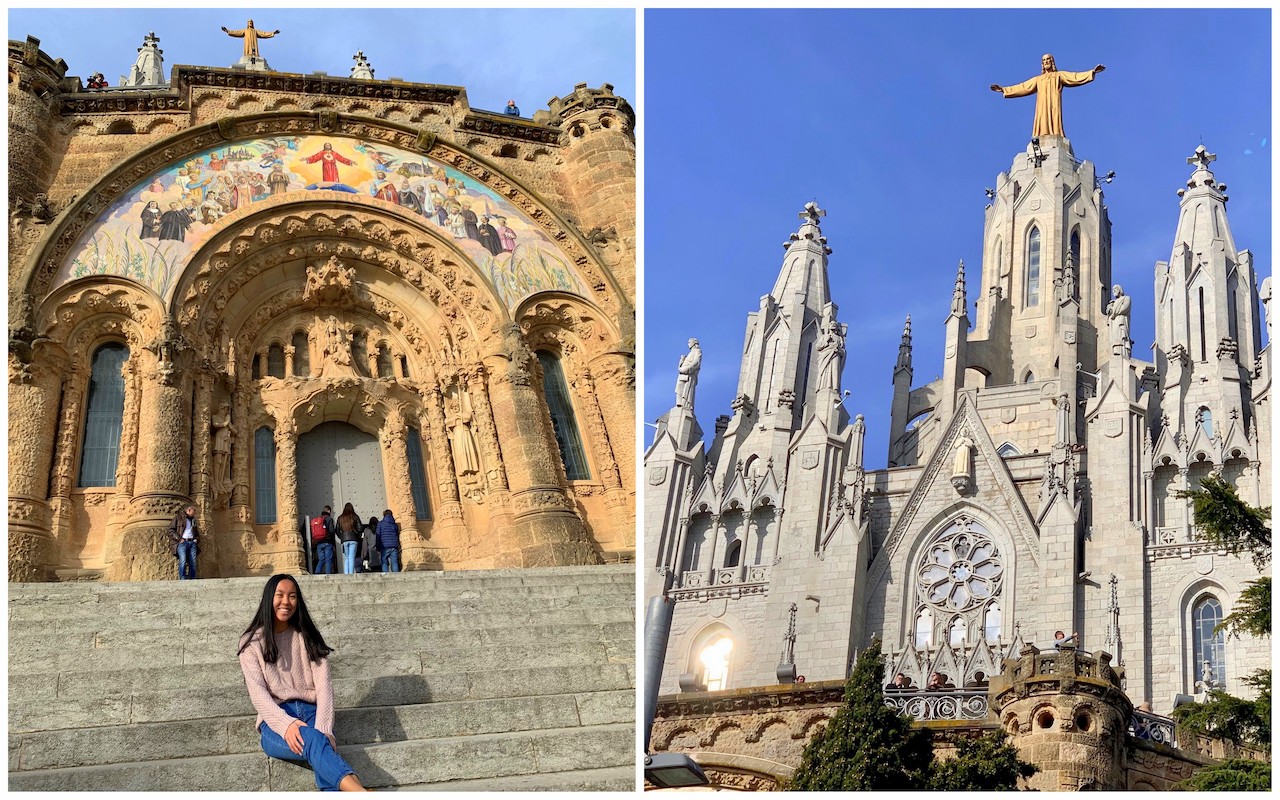
Tibidabo Amusement Park
Located at the bottom of the church and looked a bit out of place next to a religious monument was the amusement park that has been around since 1889. The park has shows and rides to entertain various age groups. Day tickets for unlimited rides (about 28 euros as of January 2020) are available.
My kids weren’t interested in riding many of the attractions and didn’t want to spend too much time at the amusement park. If we were here, ten year ago, we probably would have spent most of the day here. But, tickets are available to go on specific rides by the panoramic viewing like the carousel, plane and ferris wheel.
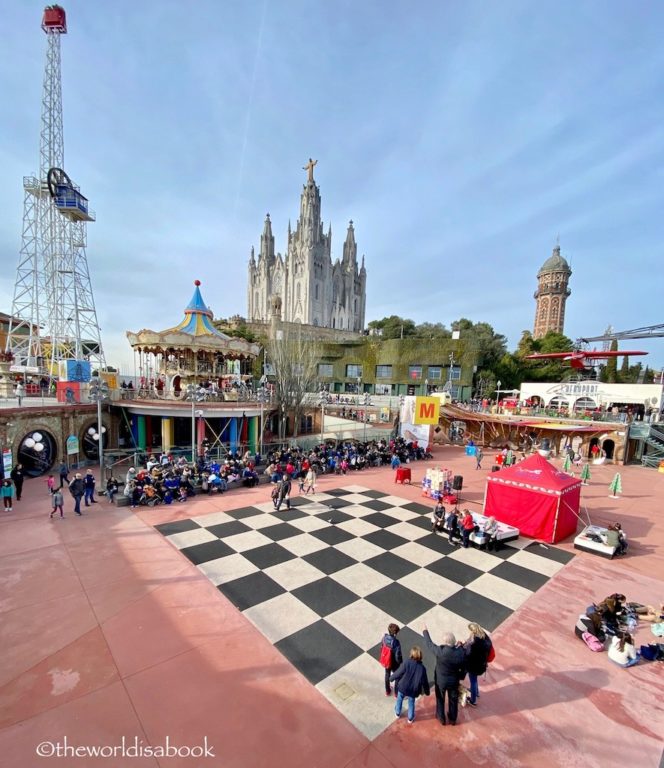
Tips for Visiting Tibidabo
- We found the easiest way to get to Tibidabo was riding the 40-minute shuttle bus called Tibibus which cost about 3 euros each way. You can catch it by the Caja Madrid Bank in the Placa de Catalunya square. There is also an option to go up via the Tramvia Blau Tram and then catching a funicular.
- Layer up. If you’re here visiting during the winter, it was a lot colder at the mountaintop especially with the wind gust.
Day 6 – Costa Brava Day trip
Our favorite day trip was driving along the Costa Brava towns. Costa Brava translates to “wild coast” in Spanish. Many small towns and villages stretch all the way to the French border line the coast. If you can fit exploring the Costa Brava area, we highly recommend it even during the wintertime. Driving is the best option.
These are the highlights and a sample of the towns we visited on our route. A detailed post will be coming soon with more photos and other villages.
Lloret de Mar was the most touristy of the towns we saw. It was definitely a resort town with its share of beachfront hotels and souvenir stores. We enjoyed walking through the historic area’s streets but especially the wide promenade along the beach. It was beautiful with Castell de Sant Joan sitting on top of the hill overlooking the ocean.
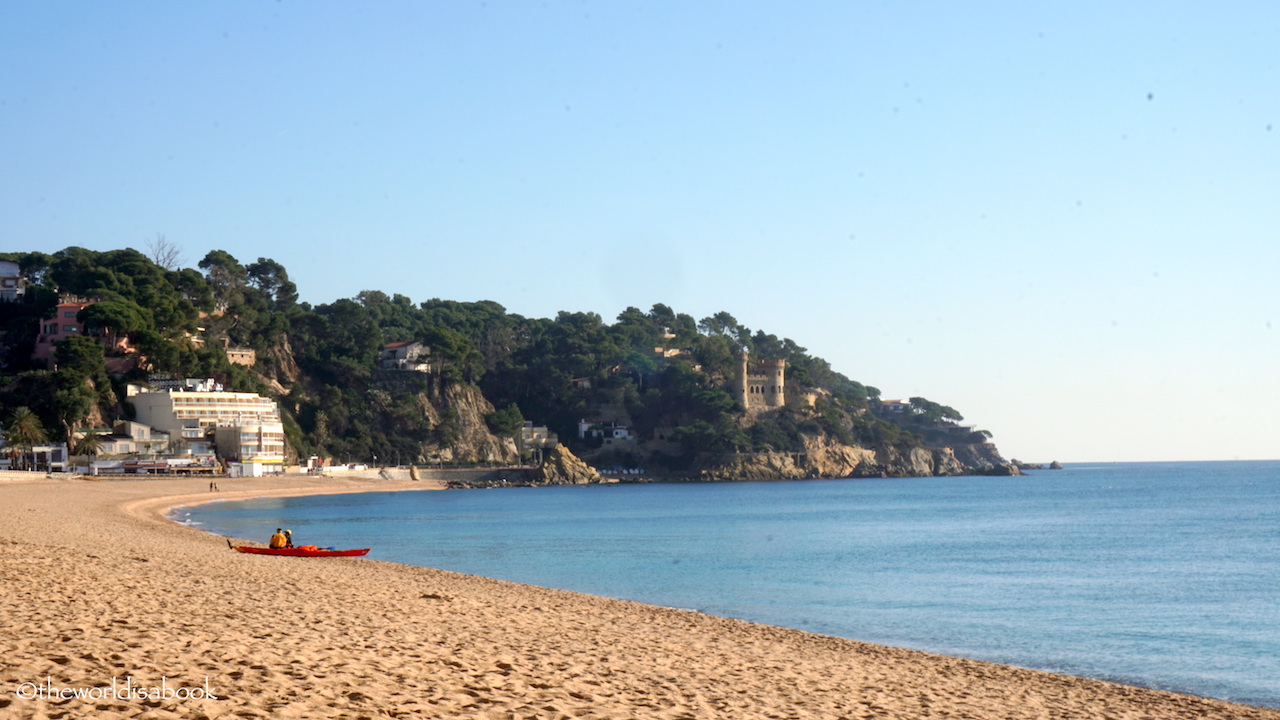
Tossa de Mar was my favorite coastal town. While the town was mostly deserted during our visit, we spent most of our time by the Platja Gran or Big Beach and then a delicious seafood lunch looking over the Mediterranean. Known as the “blue paradise”, it was postcard perfect.
It was hard to get away from this area with white washed buildings and a castle by the beach. Though, my favorite view was of La Mar Menuda Beach.
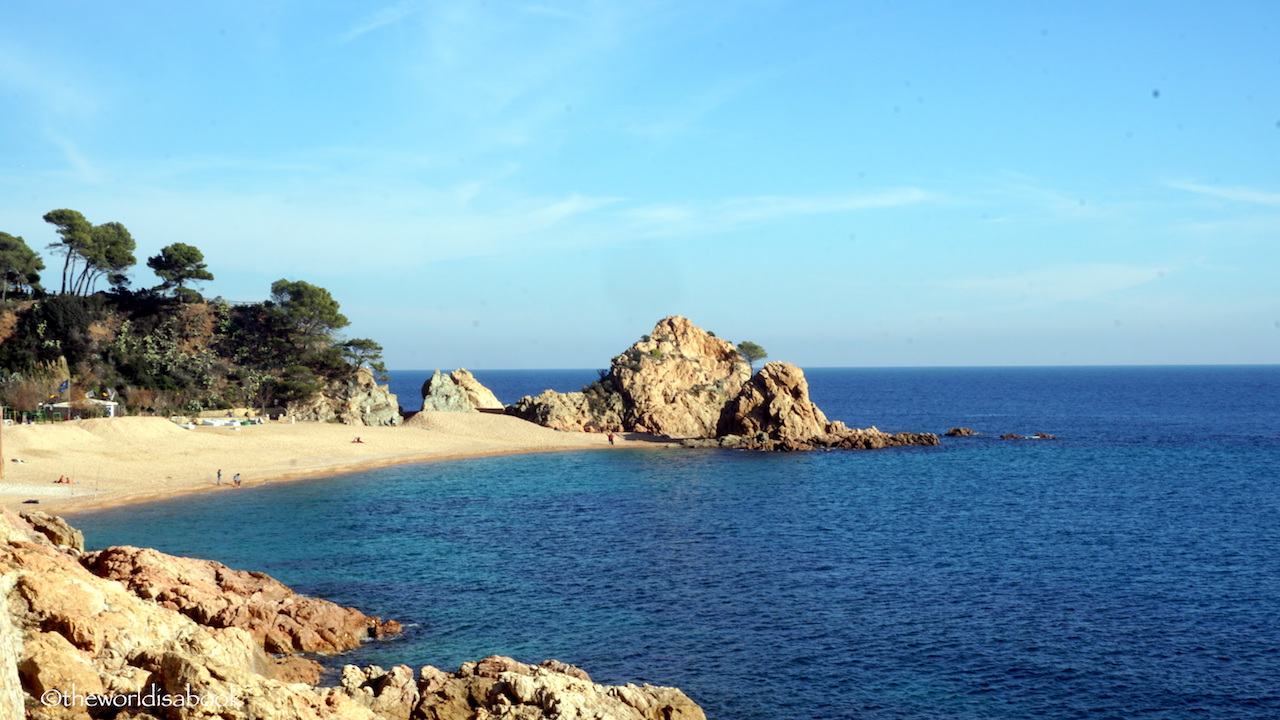
Begur was the last hilltop town we visited and were there just in time for sunset. We made the trek up to the 10th century ruins of a castle overlooking the town and the Mediterranean. This was the ideal spot for sunset viewing as it disappeared behind the mountains.
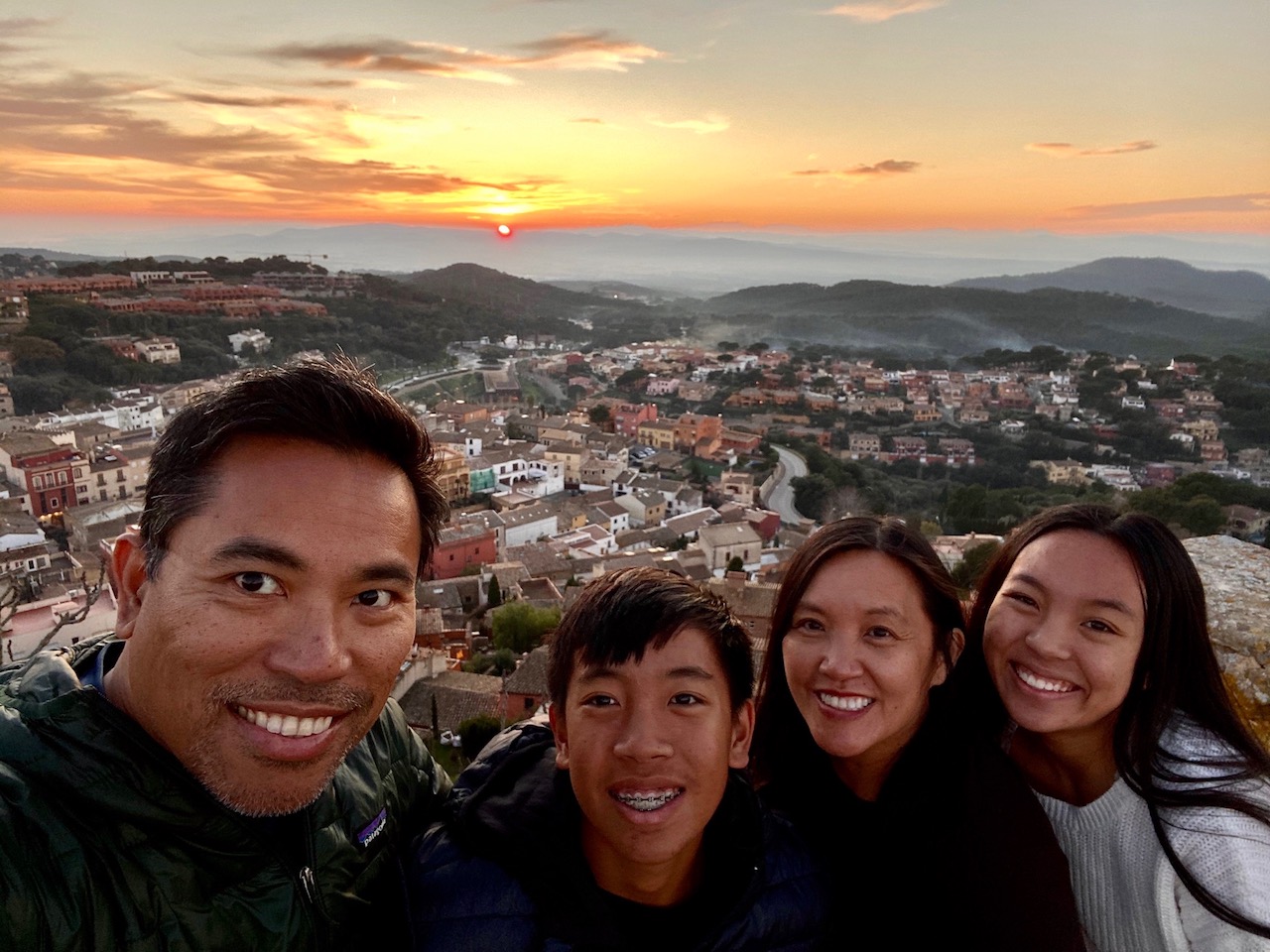
It was too bad we ran out of time to explore Begur’s beaches and coves. We would love to return for a longer stay here.
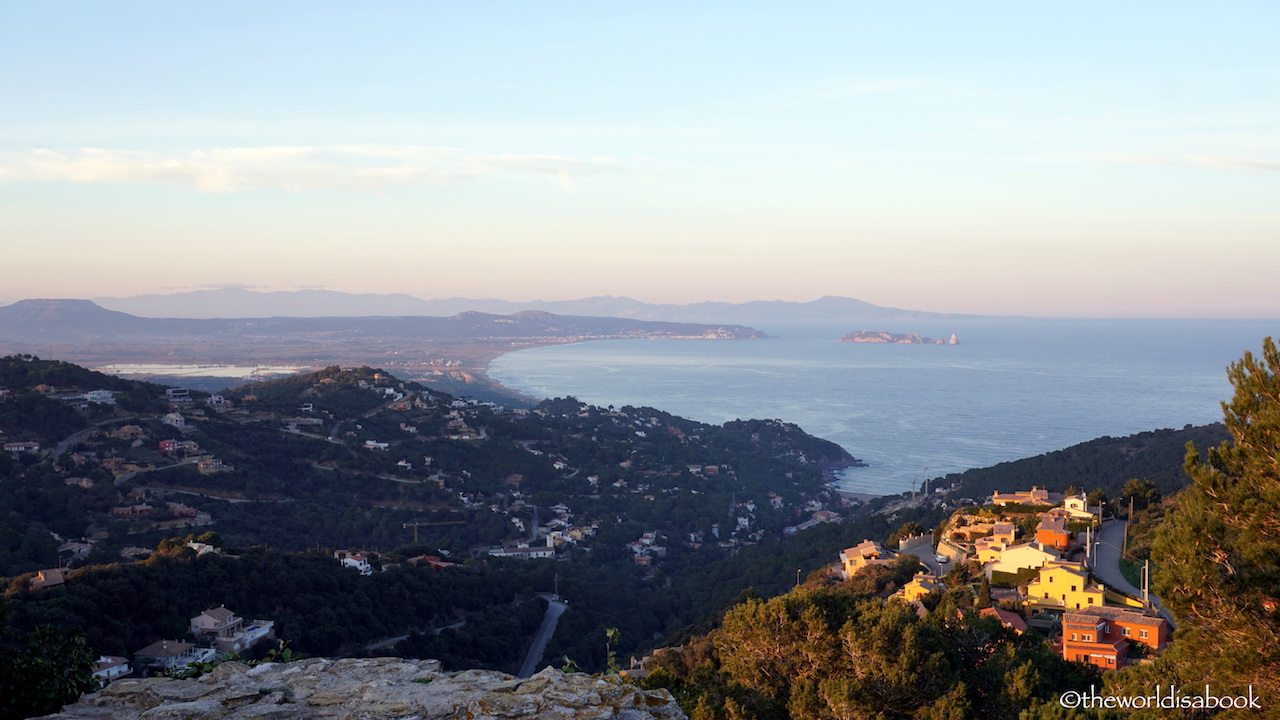
Read more about our day trip to Costa Brava and see what towns to visit from Barcelona.
Day 7 – Montserrat and Sitges
We spent our last day in Barcelona visiting the Benedictine monks’ monastery and abbey at Montserrat. I have seen many photos of this abbey over the years that I knew we had to fit it into our itinerary and it was worth the visit. You have to wonder how the people managed to create this almost fortress like structure on the mountaintop that has been around since the 15th century.
Located about an hour from Barcelona by train, this mountain sanctuary offers beautiful panoramic views of the Catalonia area. The church has a an incredible interior and is a destination for many pilgrimages to see the “Black Madonna”.
She is Catalonia’s patron saint and believed to have healing powers. The monastery also has a museum and is surrounded by a Nature park with numerous walking trails.
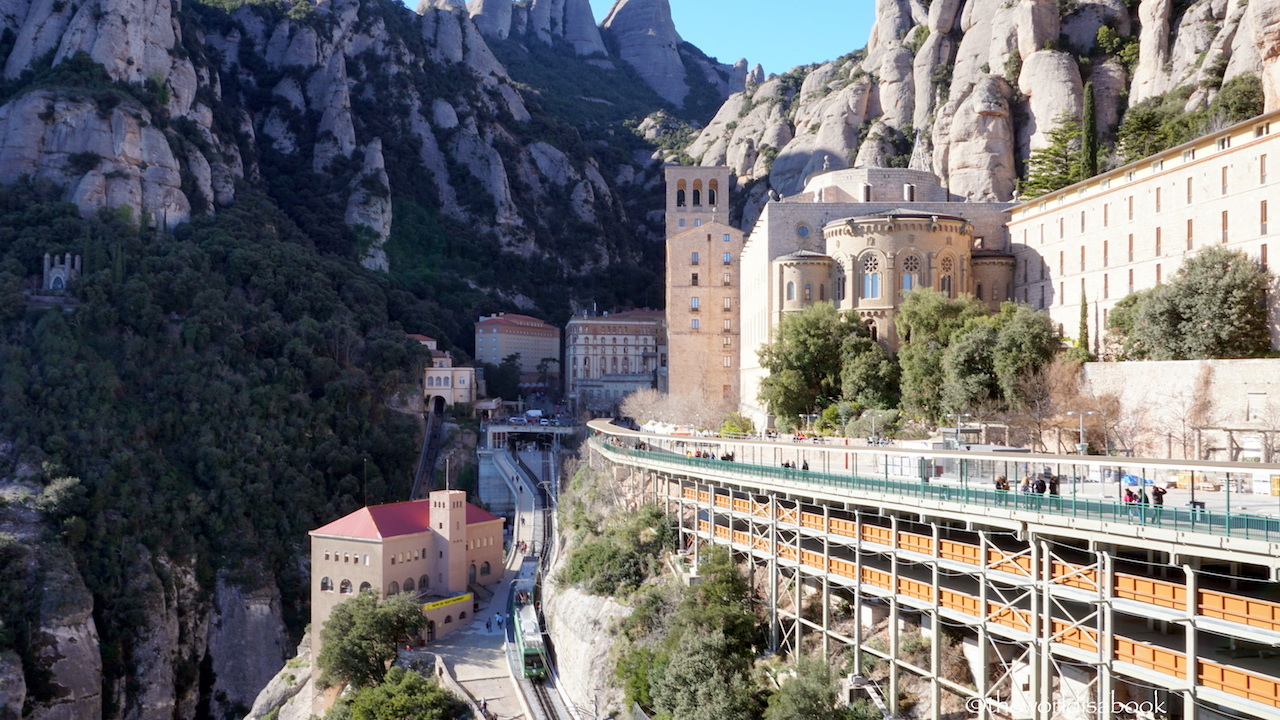
Sitges
Our final stop on our Spain exit was the beachside retreat of Sitges which was about 20 minutes from the airport. This area is known as the “Jewel of the Mediterranean” and boasts of 300 days of sunshine annually.
We loved the old town’s quaint and narrow streets that led to a beachside promenade lined with palm trees. This was a beautiful area and was crowded during our Sunday afternoon visit.
The town has about 2.5 miles of beaches and surrounded by the Garraf National park. It was quite picturesque with the Baroque Sant Bartomeu and Santa Tecla church towering over the town and coast.
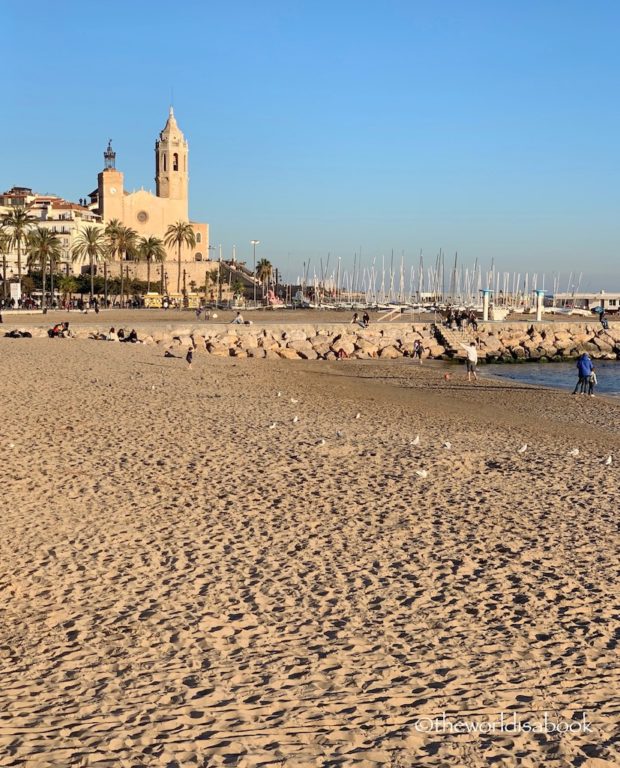
*Anything to add for this 7-day Barcelona itinerary?
The World Is A Book contains affiliate links and is a member of the Amazon Services LLC Associates Program. If you make a purchase using one of these Amazon links or any of the product links, we may receive compensation at no extra cost to you. See our Disclosure Policy for more information.
Check out these Barcelona tours
Pin it for later!
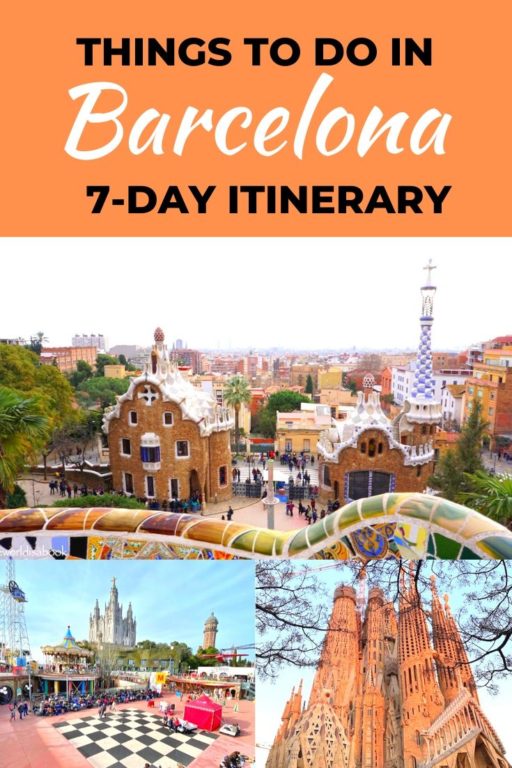
Barcelona, the city of Gaudi is always a nice city to visit, considering the beautiful architecture and there are so many things to do. Last time we visited Barcelona we only had a couple of days for visiting the city but we were still able to see a lot of things you also mentioned above. Great guide for spending an entire week in Barcelona!
Great travel tips! Now I need to get myself to Barcelona . I still have never been there. It is definitely on my bucket list. Such beautiful architecture in your photographs is something amazing.
Saved this Barcelona itinerary for later. It’s definitely on my list!
Hello! Thank you for useful tips. Planning to use your trip plan, so I would like to ask you, where did you stay during your trip and where did you rent a car (was it a good experience, any tips)?
Hello! We stayed at the Hilton Diagonal. It wasn’t right at the center but near a metro and across from a large shopping center. We rented the car with an agency that was inside the hotel. It was a great experience especially for day trips. Plan your drive in advance and account for all the tolls or a way to avoid them.
Pingback: 1xbet